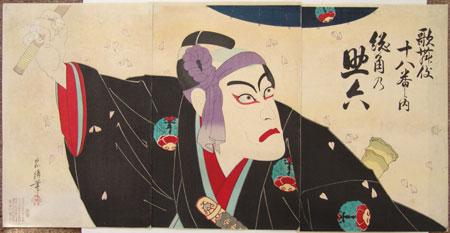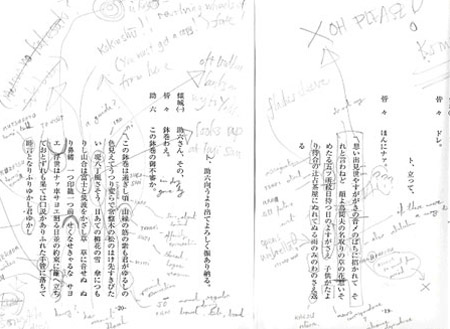
歌舞伎名作選DVDの英語字幕(English)
歌舞伎美人ウェブサイトをご利用くださる皆様はご存知のことと思いますが、この度、NHKと松竹は歌舞伎名舞台集の字幕付DVDシリーズを共同製作しました。最近のリリースは、『仮名手本忠臣蔵』、『伊達の十役』、『助六』、『阿古屋』、『茨木・魚屋宗五郎』、『幡隋長兵衛』、『毛抜・鳴神』、『御所五郎蔵』、『金閣寺』、『棒しばり・年増・供奴』、『石切梶原』、『沼津』、『義経千本桜(渡海屋・大物浦)』です。
イヤホンガイド翻訳者・ナレーターのポール・グリフィスさんと私はこれらの作品を分担しましたが、DVDの英字幕作成に完成まで6ヶ月程かかりました。まず舞台のDVDを観ながら台本を追う作業は歌舞伎座でのイヤホンガイド作成と同じです。
イヤホンガイドとDVDの大きな違いは翻訳の量でした。何故かといいますと、DVDでは字幕表示を消せるため翻訳対象内容の語数に差が出ます。歌舞伎座用のイヤホンガイドでは、ナレーターは観劇者の邪魔にならないようにコメントを控えめにしています。一方、DVDでは字幕を消して繰り返し見れるので、解説を多く入れることができます。
DVDのもうひとつの特徴は、今後何年先も販売される可能性があるので、翻訳・解説に誤りがないようにしなければいけない事です。しかしながら、100%パーフェクトな翻訳というものはありません。著名な翻訳者による翻訳ですら大幅に異なる場合もあります。それからバランスも大事です。優れた翻訳者は「直訳」という意味で正確である事と、英語の文章としてしっかりしている事を上手に両立させるようにしなければいけません。それと同時に、原文のもつ味わいや美しさと雰囲気も失われないようにしたいものです。これは非常に難しい事ですが、成し遂げたときの満足感はとても大きいです。
最初のDVDシリーズ、『仮名手本忠臣蔵』、『助六』と『阿古屋』の字幕作成の依頼がありました。吹き替え翻訳・解説の経験があるのならこれは容易な事だと読者の皆様は思いになるのではないでしょうか。ところが、倍以上の翻訳内容に付け加え、私たちは今までの経験とはまったく違った多くの課題に直面しました。
まず、口頭内容と文章内容の違いです。字幕には文字制限がある上に、一度に二行以下の文章しか表示できません。なかでも一番困難だったのは助六が登場する場の、「出端」と呼ばれる河東節でした。

写真: 鳥居忠清-1896年4月歌舞伎座にて、九代目市川團十郎による出端
[ロナルド・カヴァイエ・コレクションより]
イヤホンガイドでは次の解説が入ります。
唄われているのは「助六の、紋のように染みとおる、恋心」。見得をする助六の衣装の袂には杏葉牡丹の紋があります。助六の登場場面は「出端」と呼ばれており、いくつかのポーズで成り立った舞踊的な演技で、歌舞伎役者が演じる役柄と役者本人を観劇者に披露するものです。当時歌舞伎の支援者だった真の江戸市民、「江戸っ子」の嗜好は、現在は十二代目まで継がれている市川團十郎家のお家芸に反映されています。
翻訳も少し交えてありますが、これはほとんど解説です。同じ場面ですが、DVD字幕では、難解な日本語を翻訳することになりました。この河東節がどれほど大変であったかはメモで埋め尽くされた私の台本を見ればおわかりになると思います。

河東節-
思い出見世やすががきの音〆のばちに招かれて
Kato Bushi -
That familiar tea-house and sugagaki - the sound of the melody, plucked by the plectrum - enticing.
それと云わねど 顔よ鳥間夫の名取りの草の花思いそめたる五ツ所紋日待つ日のよすがさえ
Sukeroku of the peony crest - a courtesan's lover.
Thoughts of love permeate, deeply as the colours of the crest.
子供がたより待合の辻占茶屋にぬれてぬる雨のみのわのさえ返る
A child attendant brings news of the tryst - consummated in the tea-houses of the backstreets.
Wetness - of love-making or of rain - from which straw capes called mino, shield us at Minowa.
傾城 -
助六さん、その、鉢巻わえ
The Courtesans -
Sukeroku - that headband!
助六-
この鉢巻の御不審か
Sukeroku -
This headband, is it strange?
河東節-
この鉢巻は過ぎし頃 由縁の筋の紫も君がゆるしの色見えてうつり変らで常盤木の松のはけ先すきびたい
Kato Bushi -
The headband is of purple thread.
By her leave he wears this colour - unfading as his affections, eternal as the evergreen pine.
堤八丁風さそう
The breeze along the embankment entices men towards Yoshiwara.
目あての柳花の雪 傘につもりし山合は冨士と筑波をかざし草
On his way to the quarter, he makes for the willow, sheltering from the blossoms which fall like snow.
On one side stands the peak of Mt. Fuji and on the other Mt. Tsukuba.
草に音せぬ ぬり鼻緒
He passes silently through the grasses, but the straps on his clogs are attractive.
一つ印籠一つ前
So too are his decorative inro (purse-box) and his double-layered kimono.
せくなせきゃるな サヨエ
Do not rush.
浮世はナァ車サヨエ廻る日並の約束に籬へ立ちておとずれも果ては口説かありふれた手管におちて
Do not be hasty. The floating world of pleasure is like an ever-turning wheel.
Days pass until the lovers' promised meeting. Before the fence in front of the tea-house they meet, but it ends in a lovers' tiff. But lovers' wiles lead to words of love.
睦言となりふりゆかし君ゆかし
You are lovely, you are charming,
その翻訳者によりさまざまな解釈をすると思いますが、私なりの判断をもとに、限られた時間のなかで仕上げました。
このDVDシリーズでは今日までに至る歌舞伎の名場面を再び味わえます。私のお気に入りはというと、『伊賀越道中双六』の「沼津」です。実はあまり好きな演目ではなかったので、DVD字幕の依頼が来たときは気が向かなかったのですが、このDVDの舞台の素晴らしさには驚きました。1980年、二代目中村鴈治郎さん(1902-1983)と十三代目片岡仁左衛門さん(1903-1994)がもう70代に入っていらしたころです。関西の名優がお互いの演技から生み出すものにはお二人の長年に亘る芸の経験が表れています。
これこそ歌舞伎の面白さと素晴しさがわかる歌舞伎名作選DVDシリーズだと思いますので、是非お買い求めください。
■ロナルド・カヴァイエ
コンサートピアニストとしてロンドン、ハノーバー、ブダペストで学んだ後、1979~1986年、武蔵野音大にて教鞭をとる。現在はロンドンに住み、年に数回、コンサート、授業、講演などで来日している。
最初に歌舞伎を見たのは1979年。1982年には最初の英語イヤホンガイドの解説者になる。音楽教育と歌舞伎に関する著書があり、1993年に「Kabuki - A Pocket Guide」(Charles E. Tuttle)を日米で、2004年には「A Guide to the Japanese Stage」(講談社インターナショナル)をポール・グリフィス、扇田 昭彦との共著として出版した。
2002年には、鈴ヶ森を「Kabuki Plays on Stage Vol. III - Darkness and Desire」(University of Hawai'i Press)へと翻訳し、昨年は松竹とNHKが制作する歌舞伎DVDの新シリーズの解説、字幕制作をおこなった。
Visitors to the Kabuki-bito web site will probably know that NHK and Shochiku have recently published some more of their DVD collection of great Kabuki performances. The most recent releases include almost the entire Kanadehon Chushingura, Kurozuka, Date no Ju Yaku, Sukeroku, Akoya, Ibaraki & Sakanaya Sogoro, Banzui Chobei, Kenuki & Narukami, Gosho no Gorozo, Kinkakuji, Boshibari & Toshima & Tomo Yakko, Ishikiri Kajiwara, Numazu and the Tokaiya & Daimotsu no Ura act of Yoshitsune Senbon Zakura.
I and Paul Griffith, another English language Earphone Guide translator, commentator and narrator, divided the English translations and commentaries of all these DVDs between us - a project which took the best part of six months to conclude. The process of making a translation for a DVD is initially very similar to making an Earphone Guide for a play at the Kabuki-za. We are given the script and can watch the original performance.
The big difference between doing a translation for the Kabuki-za and doing a DVD is the amount. Let me explain. The amount of translation varies because with a DVD it's possible to turn the English off. For an Earphone Guide translation at the Kabuki-za, the commentators are very conscious not to talk too much because it could be very disturbing. With the DVD, on the other hand, we can give a lot of information, knowing that the viewer can easily watch the play again without any English.
Another factor with a DVD is that it may well be on sale for many, many years and so there is a lot of pressure not to make any mistakes. However, no translation is ever 100% perfect and sometimes compromises are necessary. Even translations by the most respected of scholars may sometimes be very different. A translator must strive to find a balance between accuracy (direct translation) and writing good English which makes sense. At the same time a good translator also tries to retain some of the beauty, feeling and flavour of the original. This is no easy task! But, when one gets it right it can be really rewarding!
For the first time in this new series of DVDs we were also asked to include subtitles for Chushingura, Sukeroku and Akoya. My readers might think that having done the spoken translation and commentary, this would not be a problem. Think again! It was twice as much work and presented us with a whole load more problems!
First of all there is quite a difference between saying something verbally and writing it down. Subtitles have the added problem of space because no single line can be very long and not more then two lines can appear on the screen at the same time. For me perhaps the most difficult part of all was the Kato Bushi lyrics for Sukeroku's famous entrance, called the Deha.

Ichikawa Danjuro IX performing the Deha at the Kabuki-za in the 4th month, 1896. Woodblock print by Torii Tadakiyo. (Ronald Cavaye collection.)
In the spoken commentary, for example. I have the following -
"The musicians continue - "Thoughts of love permeate, deeply as the colours of Sukeroku's crest." As he poses we see the peony crest on his sleeve. In Kabuki the actor behind the role is rarely forgotten. Sukeroku's entrance is called the deha and is a series of dance-like poses during which the actor presents to his fans both the role he is playing and also himself. The Edokko, the true citizen of Edo, were great patrons of Kabuki and their tastes were reflected in the acting style developed by the line of Danjuro actors of which the present is the twelfth."
This gives a little translation but is mostly explanation. At this same point in the subtitles, however, I had to translate some extremely difficult Japanese. A glance at the pencil markings on my script will show you just how much trouble these Kato Bushi lyrics gave me -

Kato Bushi -
That familiar tea-house and sugagaki - the sound of the melody, plucked by the plectrum - enticing.
Sukeroku of the peony crest - a courtesan's lover.
Thoughts of love permeate, deeply as the colours of the crest.
A child attendant brings news of the tryst - consummated in the tea-houses of the backstreets.
Wetness - of love-making or of rain - from which straw capes called mino, shield us at Minowa.
The Courtesans -
Sukeroku - that headband!
Sukeroku -
This headband, is it strange?
Kato Bushi -
The headband is of purple thread.
By her leave he wears this colour - unfading as his affections, eternal as the evergreen pine.
The breeze along the embankment entices men towards Yoshiwara.
On his way to the quarter, he makes for the willow, sheltering from the blossoms which fall like snow.
On one side stands the peak of Mt. Fuji and on the other Mt. Tsukuba.
He passes silently through the grasses, but the straps on his clogs are attractive.
So too are his decorative inro (purse-box) and his double-layered kimono.
Do not rush. Do not be hasty. The floating world of pleasure is like an ever-turning wheel.
Days pass until the lovers' promised meeting. Before the fence in front of the tea-house they meet, but it ends in a lovers' tiff. But lovers' wiles lead to words of love.
You are lovely, you are charming,
I am sure that other scholars may choose to translate sections of this differently but, within the time constraints, I had, for better or worse, to make a decision and stick with it.
The addition of these DVDs to the collection is a fantastic opportunity to relive some of Kabuki's finest performances. As for my own favourite? To tell the truth, when I was given Numazu (full title, Igagoe Dochu Sugoroku), I was not particularly pleased as that is not one of my most loved plays. But I was in for a big surprise! This performance took place in 1980 when the two stars, Nakamura Ganjiro II (1902-1983) and Kataoka Nizaemon XIII (1903-1994), were well into their seventies. And their performances were wonderful - an absolute delight! Two master Kansai actors working and playing off each other in a way which highlights their countless years of experience.
All these DVD performances show Kabuki at its best. Buy them!
Ronald Cavaye will be sending another letter next month.
Ronald Cavaye
Ronald Cavaye is a concert pianist who studied in London, Hannover and Budapest. He was professor of piano at the Musashino Academy of Music in Tokyo between 1979-1986. Now living in London, he returns to Japan several times a year for concerts, teaching and lectures.
Ronald Cavaye first saw a Kabuki play in 1979 and in 1982 became one of the first narrators (kaisetsusha) of the English Earphone Guide. He has written books on music education and Kabuki - "Kabuki - A Pocket Guide": Charles E. Tuttle, USA and Japan, 1993 and "A Guide to the Japanese Stage": (with Paul Griffith and Akihiko Senda), Kodansha International, Japan, 2004.
He translated Suzugamori for "Kabuki Plays on Stage Vol. III - Darkness and Desire": University of Hawai'i Press, 2002 and for the past year has been working on the commentaries and subtitles of the new series of Kabuki DVDs being produced by Shochiku and NHK.
